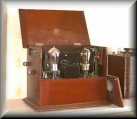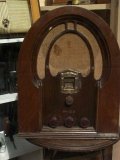Hook
The opening 30 seconds of the play - called
the "hook".
| 'Hook' on to the listeners' attention - so they do not switch off. |
| Entertain your listeners |
| Let the listeners know the genre of the play - and the mood |
| Often (most often?) establish the play's protagonist (leading character) |
| In 'art' radio plays, a montage might be used. See EXPERIMENTAL radio drama pieces |
| Acting? - you have to work especially at this. You may have to record this early on, before you have fully discovered the character. |
| Directing? - try to record this later, when your actors have really discovered character and voice. |
| Scripting? - redraft and rethink - this is so important. Listen to lots of radio plays. |
| For scripting and production examples, see Signposting - further. |
| STRAIGHT IN TO OPENING SCENE (as the 'HOOK')? Make special use of establishing the ATMOS (see techniques there) at the top of the scene. |
| In FILM, the hook, is longer and is the inciting incident. It takes usually ten pages (or ten minutes) to grab a cinema audience. |
|
The scripting and direction must "hook on"
to the listeners' attention and encourage them to listen, and
not to go for the off switch. The hook is an established term in radio production. The hook needs to be the subject of special analysis, in terms of writing, production and how the listener is to get engaged, and of its entertainment values. A variety of hooks are used, and the greatest contrast is between the BBC afternoon play and the Radio 3 play. The hook will establish both the mood and genre. It is vital as a device in establishing these and may make use of extra-diegetic music or diegetic music. It will often use a few clearly-recognisable sound effects. In establishing location too, it functions as the "signpost". As regards this function, "hook" and "signpost" are overlapping terms. The hook will generate expectations for the listener not least of being entertained. In some few example, there is an extended sound montage for the hook, or some greater elaboration.
And ditto a contrast to the stage play, which rarely begins the first scene at a rapid pace and by going to the heart of the action. The hook may also indicate that the dominant genre of the play is a comedy, or serious, or a thriller, even though the opening scene or scenes are in another mood. To Welcome Page
Comments on the hook McWhinnie, THE ART OF RADIO (1959) 132: McWhinnie, Donald, 1959, The Art of Radio, London: Faber and Faber.
Felton, THE RADIO-PLAY: ITS TECHNIQUES AND POSSIBILITIES (1949)
28: Felton, Felix, 1949, The Radio-play: its techniques and possibilities,
London: Sylvan Press. Gielgud, THE RIGHT WAY TO RADIO PLAYWRITING (1948) 23:
Suderman in the Radio Times 31/7/58 p175:
Assignment on the hook (students) CONTINUING THROUGH THIS SITE Further into this site: signposting Or back to top of the scene - signposting & description
|
|
|
||
|
|
|
|
| establish presence |
|
|
| Perspective |
|
|
|
|
|
|
|
|
|
|
|
|
|
|
|
|
|
|
|
|
|
|
|
|
|
|
|
'moving camera' technique |
|
|
|
'Will you turn that music down!' |
| drop-ins | sound pictures |
|
| number the scenes carefully with a system | voice in the mind = interiorizing |
|
Styles of production, directing and post-production
|
|
|
story board |
|
|
|
|
|
|
Theoretical issues & writing-up your project
|
|
|
|
| language based = logocentric |
|
|
|
|
|
|




